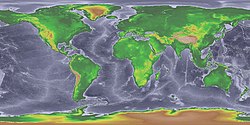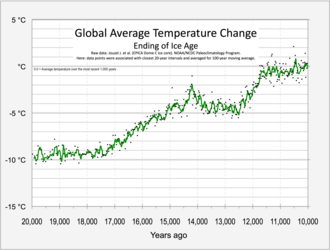
Back Pleistoseen Afrikaans Pleistozän ALS अभिनूतन युग ANP العصر الحديث الأقرب Arabic بليستوسين ARZ Pleistocenu AST Pleystosen epoxası Azerbaijani Плейстацэн Byelorussian Плейстоцен Bulgarian প্লাইস্টোসিন Bengali/Bangla
| Pleistocene | |
|---|---|
 The world during the last ice age, 113,000–9,700 BC | |
| Chronology | |
| Etymology | |
| Name formality | Formal |
| Usage information | |
| Celestial body | Earth |
| Regional usage | Global (ICS) |
| Definition | |
| Chronological unit | Epoch |
| Stratigraphic unit | Series |
| Time span formality | Formal |
| Lower boundary definition |
|
| Lower boundary GSSP | Monte San Nicola Section, Gela, Sicily, Italy 37°08′49″N 14°12′13″E / 37.1469°N 14.2035°E |
| Lower GSSP ratified | 2009 (as base of Quaternary and Pleistocene)[3] |
| Upper boundary definition | End of the Younger Dryas stadial |
| Upper boundary GSSP | NGRIP2 ice core, Greenland 75°06′00″N 42°19′12″W / 75.1000°N 42.3200°W |
| Upper GSSP ratified | 2008 (as base of Holocene)[4] |
| Part of a series on |
| Human history and prehistory |
|---|
| ↑ before Homo (Pliocene epoch) |
| ↓ Future (Holocene epoch) |
The Pleistocene (/ˈplaɪstəˌsiːn, -stoʊ-/ PLY-stə-seen, -stoh-;[5][6] referred to colloquially as the Ice Age) is the geological epoch that lasted from c. 2.58 million to 11,700 years ago, spanning the Earth's most recent period of repeated glaciations. Before a change was finally confirmed in 2009 by the International Union of Geological Sciences, the cutoff of the Pleistocene and the preceding Pliocene was regarded as being 1.806 million years Before Present (BP). Publications from earlier years may use either definition of the period. The end of the Pleistocene corresponds with the end of the last glacial period and also with the end of the Paleolithic age used in archaeology. The name is a combination of Ancient Greek πλεῖστος (pleîstos) 'most' and καινός (kainós; Latinized as cænus) 'new'.
At the end of the preceding Pliocene, the previously isolated North and South American continents were joined by the Isthmus of Panama, causing a faunal interchange between the two regions and changing ocean circulation patterns, with the onset of glaciation in the Northern Hemisphere occurring around 2.7 million years ago. During the Early Pleistocene (2.58–0.8 Ma), archaic humans of the genus Homo originated in Africa and spread throughout Afro-Eurasia. The end of the Early Pleistocene is marked by the Mid-Pleistocene Transition, with the cyclicity of glacial cycles changing from 41,000-year cycles to asymmetric 100,000-year cycles, making the climate variation more extreme. The Late Pleistocene witnessed the spread of modern humans outside of Africa as well as the extinction of all other human species. Humans also spread to the Australian continent and the Americas for the first time, co-incident with the extinction of most large-bodied animals in these regions.
The aridification and cooling trends of the preceding Neogene were continued in the Pleistocene. The climate was strongly variable depending on the glacial cycle, with the sea levels being up to 120 metres (390 ft) lower than present at peak glaciation, allowing the connection of Asia and North America via Beringia and the covering of most of northern North America by the Laurentide Ice Sheet.


- ^ Cohen, K. M.; Finney, S. C.; Gibbard, P. L.; Fan, J.-X. (January 2020). "International Chronostratigraphic Chart" (PDF). International Commission on Stratigraphy. Retrieved 23 February 2020.
- ^ Mike Walker; et al. (December 2018). "Formal ratification of the subdivision of the Holocene Series/Epoch (Quaternary System/Period)" (PDF). Episodes. 41 (4). Subcommission on Quaternary Stratigraphy (SQS): 213–223. doi:10.18814/epiiugs/2018/018016. Retrieved 11 November 2019.
- ^ Gibbard, Philip; Head, Martin (September 2010). "The newly-ratified definition of the Quaternary System/Period and redefinition of the Pleistocene Series/Epoch, and comparison of proposals advanced prior to formal ratification" (PDF). Episodes. 33 (3): 152–158. doi:10.18814/epiiugs/2010/v33i3/002. Retrieved 8 December 2020.
- ^ Walker, Mike; Johnse, Sigfus; Rasmussen, Sune; Steffensen, Jørgen-Peder; Popp, Trevor; Gibbard, Phillip; et al. (June 2008). "The Global Stratotype Section and Point (GSSP) for the base of the Holocene Series/Epoch (Quaternary System/Period) in the NGRIP ice core". Episodes. 31 (2): 264–267. doi:10.18814/epiiugs/2008/v31i2/016. hdl:10289/920.
- ^ Jones, Daniel (2003) [1917]. "Pleistocene". In Peter Roach; James Hartman; Jane Setter (eds.). English Pronouncing Dictionary. Cambridge: Cambridge University Press. ISBN 3-12-539683-2.
- ^ "Pleistocene". Dictionary.com Unabridged (Online). n.d.
- ^ Zalloua, Pierre A.; Matisoo-Smith, Elizabeth (6 January 2017). "Mapping Post-Glacial expansions: The Peopling of Southwest Asia". Scientific Reports. 7: 40338. Bibcode:2017NatSR...740338P. doi:10.1038/srep40338. ISSN 2045-2322. PMC 5216412. PMID 28059138.